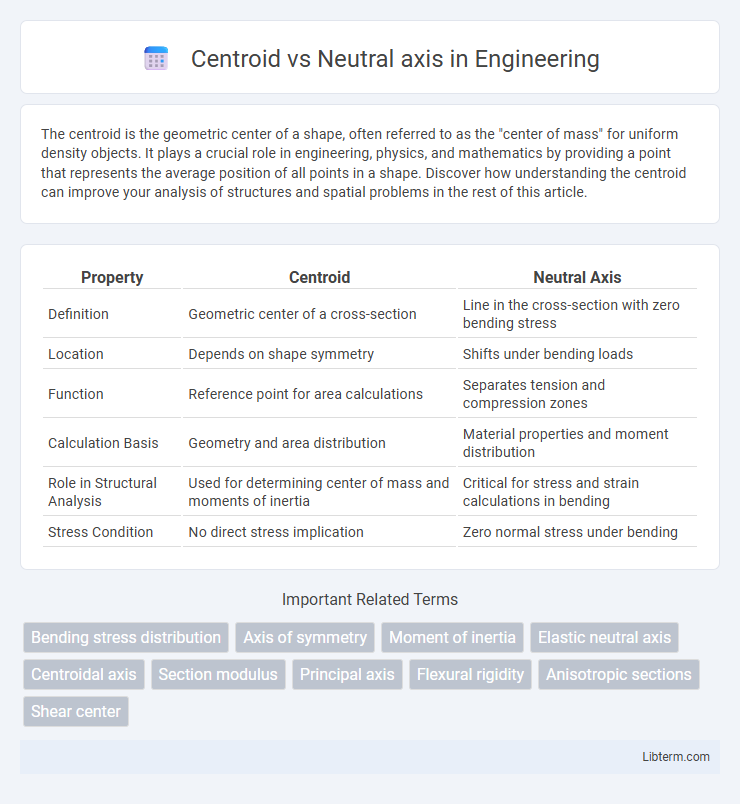The centroid is the geometric center of a shape, often referred to as the "center of mass" for uniform density objects. It plays a crucial role in engineering, physics, and mathematics by providing a point that represents the average position of all points in a shape. Discover how understanding the centroid can improve your analysis of structures and spatial problems in the rest of this article.
Table of Comparison
| Property | Centroid | Neutral Axis |
|---|---|---|
| Definition | Geometric center of a cross-section | Line in the cross-section with zero bending stress |
| Location | Depends on shape symmetry | Shifts under bending loads |
| Function | Reference point for area calculations | Separates tension and compression zones |
| Calculation Basis | Geometry and area distribution | Material properties and moment distribution |
| Role in Structural Analysis | Used for determining center of mass and moments of inertia | Critical for stress and strain calculations in bending |
| Stress Condition | No direct stress implication | Zero normal stress under bending |
Introduction to Centroid and Neutral Axis
The centroid is the geometric center of a shape or area, representing the average position of all points within the shape. The neutral axis is a specific line passing through the centroid where bending stress transitions from tension to compression in a beam under load. Understanding the relationship between the centroid and neutral axis is crucial for accurately analyzing bending moments and stresses in structural engineering.
Definition of Centroid
The centroid is the geometric center or average position of all the points in a shape, representing the point where the shape's area is evenly distributed. It serves as a fundamental reference in structural engineering for locating the neutral axis, which is the line through the cross-section where the bending stress is zero during flexural loading. Calculating the centroid involves integrating the coordinates of the shape's area, ensuring accurate determination of bending stresses and moment distribution.
Definition of Neutral Axis
The neutral axis is the line within a beam or structural element where the material experiences zero longitudinal stress during bending, meaning it undergoes neither compression nor tension. It typically passes through the centroid of the cross-section in symmetrical, homogeneous materials but can shift in unsymmetrical or composite sections. Understanding the neutral axis's precise location is crucial for accurate stress analysis and structural design.
Fundamental Differences Between Centroid and Neutral Axis
The centroid represents the geometric center of a cross-sectional shape, calculated purely based on area distribution without considering material properties. The neutral axis is the line within a bending member where the fiber experiences zero stress during bending, determined by both geometry and the material's elastic modulus. Unlike the centroid, the neutral axis shifts in composite sections due to varying stiffness, reflecting the fundamental difference between geometric and stress analysis perspectives.
Importance in Structural Analysis
The centroid represents the geometric center of a cross-section, crucial for locating the neutral axis where bending stress is zero in structural analysis. Accurately determining the neutral axis allows engineers to predict stress distribution and design safe, efficient beams and columns under bending loads. Understanding the distinction between centroid and neutral axis ensures precise calculation of moments of inertia, essential for evaluating structural stability and performance.
How to Locate the Centroid
The centroid is located by calculating the geometric center of a shape, typically using the method of dividing the figure into simpler shapes and finding the weighted average of their centroids based on area. For composite areas, summing the moments of individual areas about a reference axis and dividing by the total area yields the centroid coordinates. This differs from the neutral axis, which is the line in a beam or structural member where the bending stress is zero during bending.
How to Determine the Neutral Axis
The neutral axis in a beam under bending is the line where the bending stress is zero, located through the centroid of the cross-sectional area. To determine the neutral axis, calculate the centroid coordinates by balancing the moments of the cross-sectional area about the reference axes. Use the formula \( \bar{y} = \frac{\sum (A_i y_i)}{\sum A_i} \) where \(A_i\) and \(y_i\) represent the area and centroidal distance of each segment, ensuring the neutral axis passes through this centroid point.
Centroid and Neutral Axis in Different Geometries
The centroid represents the geometric center of an area or volume, while the neutral axis is the line within a beam or structural member where bending stress is zero during flexural loading. In symmetric geometries like rectangles and circles, the neutral axis coincides with the centroidal axis, but in asymmetric or composite sections, the neutral axis shifts away from the centroid due to varying material properties or shape irregularities. Accurate determination of both centroid and neutral axis positions is critical for precise stress analysis and structural design in beams, channels, and I-sections.
Applications in Engineering Design
Centroid and neutral axis are critical concepts in engineering design, affecting structural analysis and material performance. The centroid represents the geometric center of a cross-section, essential for calculating moments of inertia, while the neutral axis is the line within a beam where bending stress transitions from tension to compression, crucial for stress distribution. Accurate identification of both ensures optimized beam design, enhanced load-bearing capacity, and improved safety in civil, mechanical, and aerospace engineering applications.
Summary: Choosing Between Centroid and Neutral Axis
The centroid represents the geometric center of a cross-section, crucial for locating the center of mass and calculating moment of inertia in structural analysis. The neutral axis, however, specifically defines the line within a beam or structural member where bending stress is zero during flexural loading. Selecting between the centroid and neutral axis depends on the application: use the centroid for general geometric properties and the neutral axis for stress analysis in bending scenarios.
Centroid Infographic

 libterm.com
libterm.com